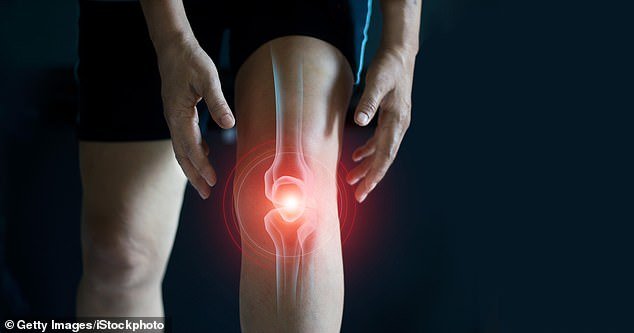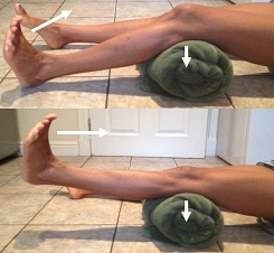Knee pain is a common problem and can be caused by numerous things, from running and ligament damage to arthritis.
According to research, more than one in five people over the age of 40 have some form of chronic knee pain global estimates.
But just because it’s common doesn’t mean you have to put up with it.
Chronic pain can affect how active you are and experts say basic exercises can significantly help most knee problems.
Here, MailOnline asks the experts what causes knee pain and how to treat it.
Damage to the cartilage in the knee and torn ligaments, which hold the knee together, are common injuries that occur as a result of trauma. This could be caused by a sports injury, experts say
Causes of knee pain
In most cases, knee pain is caused by trauma from a sports injury or at work.
Damage to the cartilage in the knee and torn ligaments, which hold the knee together, are common injuries that occur as a result of trauma.
Although cartilage tears can heal on their own, experts warn that damage to the ligaments may require surgery.
But experts say the most common cause of knee pain varies with age.
In younger people, knee pain is usually caused by injury or sudden movements that stress the knee, leading to sprained or strained knee ligaments, torn cartilage or tendonitis from overuse, according to Professor Karen Barker, an expert in physiotherapy at Oxford. University.
‘In young adults, knee pain can result from sports injuries where tendons around the joint or cartilage within the joint are damaged,’ says Professor Philip Conaghan, an expert in rheumatic and musculoskeletal medicine at the University of Leeds.
This pain can be felt in the front of the knee and is usually related to problems with the tendon that contains the kneecap. It can also be caused by the position of the kneecap.
He added: ‘Another cause in young people is pain in the front of the knee, which can mean inflammation of the tendon around the kneecap, and this may be more common in people with stretchy joints, also known as hypermobility .’
However, for people over 40, knee pain is often a sign of arthritis.
‘For most people over 40, the most common cause of knee pain is probably a combination of tendon problems and underlying osteoarthritis, the type of arthritis that most people get as they get older, and the accumulation of minor knee damage over many years,’ says Professor Conaghan.
The symptoms to look out for
Swelling, pain and stiff joints are all symptoms of arthritis.
It affects millions of people in the UK and can affect people of all ages, including children.
Professor Barker explained that the joint may feel warm to the touch.
She added: ‘There may be popping or cracking grating sounds with movement, known as crepitus.
‘Other symptoms in more severe cases include an inability to fully extend the knee and pain when walking or taking weight through the leg.’
But there are many triggers for knee pain and types of arthritis.
‘There are many different types of arthritis, but we try to distinguish mechanical joint problems, such as tendon problems and osteoarthritis, which are common, from inflammatory arthritis, such as rheumatoid arthritis or gout,’ says Professor Conaghan.
Both mechanical and inflammatory joint problems can cause swelling, but there is a difference between the two.
Mechanical joint problems are often associated with having stiff joints in the first 10 to 15 minutes after standing or after sitting for long periods of time and then improve with movement, according to Professor Conaghan.
He said: ‘Generally the symptoms get worse the more you are on your feet during the day. We know that people with osteoarthritis often experience complaints when climbing stairs.’
But when it comes to inflammatory arthritis, people experience morning stiffness in the joints for hours or severely painful acute attacks such as with gout, he explains.
Infections such as salmonella can also cause acute inflammatory arthritis with a large swollen knee, experts say.
Although clicking joints are not usually a cause for concern, Professor Conaghan warns that the ‘feeling of the knee ‘giving way’ usually means weak thigh muscles rather than ligament damage’.

Mechanical joint problems are often associated with stiff joints in the first 10 to 15 minutes after standing or after sitting for long periods of time and then improve with movement, according to Professor Conaghan
When should you consult a doctor?
Knee pain that gets worse with movement and pain that doesn’t seem to improve are both warning signs that you should see a doctor.
Professor Conaghan said: ‘If you have had an obvious knee injury within an hour with acute and extensive swelling of the knee, it is worth getting checked to see if you have torn a knee ligament.
“If you get a lot of knee swelling without any trauma, you may need to see a doctor, especially if the knee feels very warm or tender, or if you have a fever.”
“If you have known arthritis such as gout or rheumatoid arthritis and you experience increased pain or swelling in the knee, you may need a change in medication.”
But Professor Barker says that if the ‘onset is gradual or traumatic injury without major impact’, patients should use ice and rest the joint to reduce swelling and use over-the-counter painkillers, such as paracetamol, to control the pain .
People aged 45 or over who have activity-related joint pain and stiffness in the morning can be diagnosed with osteoarthritis without an X-ray or MRI scan, according to guidance from regulator NICE.
But even after a diagnosis, surgery is a ‘last resort’, explains Professor Barker.
She said: ‘Surgery is a last resort for knee arthritis and should only be considered in severe osteoarthritis if other measures have failed, such as weight loss, exercise, physiotherapy, painkillers and after a minimum of 3 to 6 months. of non-surgical treatment before referral.’
Treating knee pain
Knee pain can be caused by weak muscles and sometimes strengthening the muscles around the knee can help.
‘Sometimes muscle weakness precedes knee pain; weak muscles lead to tendon pain around the knee,” says Professor Conaghan.
He explains that as we age we lose muscle mass, especially with sedentary work.
In addition, people who develop knee pain also quickly lose muscle mass.
He said: ‘So everyone needs thigh muscle strengthening.
‘The main signs of weak thigh muscles are difficulty getting out of a deep chair or car without using your arms, difficulty getting out of the bath or the feeling that your knee is ‘giving way’.’
But there are a few exercises that can target the right muscles.
‘The good thing is that for most people, basic exercises can have a profound effect on improving knee pain and also on improving joint function,’ says Dr Darren Player, Lecturer in Musculoskeletal Bioengineering at University College London (UCL).
Dr. Player encourages strength and stability exercises such as knee extensions, stair climbing, simple supine knee bends, static quad exercises and sit-to-stand exercises.
He said: ‘Based on the initial strength, symptoms and the underlying condition, it may be possible to perform more complex exercises such as lunges which help strengthen and stabilize.
‘Progress should be steady – working towards 8-10 reps for each exercise, repeated 3-4 times with plenty of rest.’
But these exercises should not cause acute pain. If that is the case, Dr. Player to limit the number of reps or sets and allow for more rest time.
He added: ‘As with any form of exercise, some soreness may be felt in the days following, but this is part of the natural regeneration process.’
Some people with very weak knees require lighter exercises.
Professor Conaghan said: ‘Many people who are very weak will find that doing multiple laps in a pool is an easy way to build muscle.
‘See a physiotherapist to give you one or two thigh muscle exercises every day, such as straight raises while lying down.
‘The key is to get into the habit of doing your strengthening exercises and, as you get stronger, move on to more aerobic strengthening exercises such as stationary bikes or ellipticals.’

